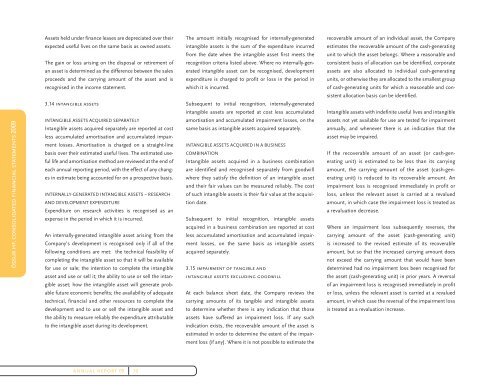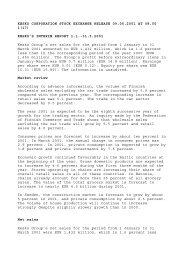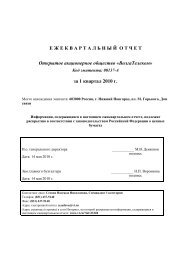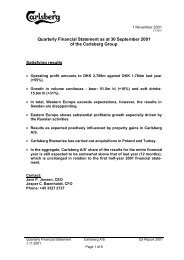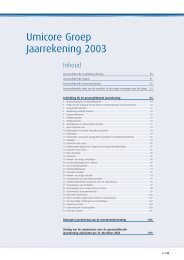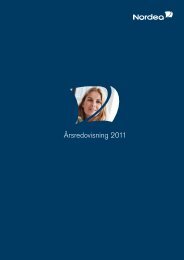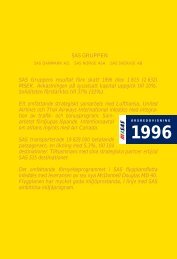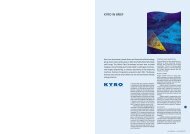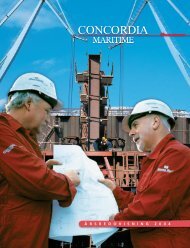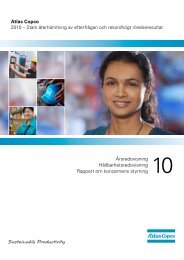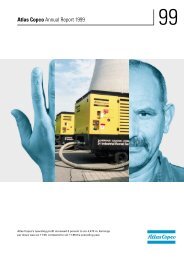össur annual report2009 - Euroland
össur annual report2009 - Euroland
össur annual report2009 - Euroland
Create successful ePaper yourself
Turn your PDF publications into a flip-book with our unique Google optimized e-Paper software.
Össur hf. consolidated financial stateMents 2009<br />
Assets held under finance leases are depreciated over their<br />
expected useful lives on the same basis as owned assets.<br />
The gain or loss arising on the disposal or retirement of<br />
an asset is determined as the difference between the sales<br />
proceeds and the carrying amount of the asset and is<br />
recognised in the income statement.<br />
3.14 intangible assets<br />
INTANGIBLE ASSETS ACQUIRED SEPARATELY<br />
Intangible assets acquired separately are reported at cost<br />
less accumulated amortisation and accumulated impairment<br />
losses. Amortisation is charged on a straight-line<br />
basis over their estimated useful lives. The estimated useful<br />
life and amortisation method are reviewed at the end of<br />
each <strong>annual</strong> reporting period, with the effect of any changes<br />
in estimate being accounted for on a prospective basis.<br />
INTERNALLY-GENERATED INTANGIBLE ASSETS – RESEARCH<br />
AND DEvELOPMENT EXPENDITURE<br />
Expenditure on research activities is recognised as an<br />
expense in the period in which it is incurred.<br />
An internally-generated intangible asset arising from the<br />
Company’s development is recognised only if all of the<br />
following conditions are met: the technical feasibility of<br />
completing the intangible asset so that it will be available<br />
for use or sale; the intention to complete the intangible<br />
asset and use or sell it; the ability to use or sell the intangible<br />
asset; how the intangible asset will generate probable<br />
future economic benefits; the availability of adequate<br />
technical, financial and other resources to complete the<br />
development and to use or sell the intangible asset and<br />
the ability to measure reliably the expenditure attributable<br />
to the intangible asset during its development.<br />
<strong>annual</strong> report 09<br />
70<br />
The amount initially recognised for internally-generated<br />
intangible assets is the sum of the expenditure incurred<br />
from the date when the intangible asset first meets the<br />
recognition criteria listed above. Where no internally-generated<br />
intangible asset can be recognised, development<br />
expenditure is charged to profit or loss in the period in<br />
which it is incurred.<br />
Subsequent to initial recognition, internally-generated<br />
intangible assets are reported at cost less accumulated<br />
amortisation and accumulated impairment losses, on the<br />
same basis as intangible assets acquired separately.<br />
INTANGIBLE ASSETS ACQUIRED IN A BUSINESS<br />
COMBINATION<br />
Intangible assets acquired in a business combination<br />
are identified and recognised separately from goodwill<br />
where they satisfy the definition of an intangible asset<br />
and their fair values can be measured reliably. The cost<br />
of such intangible assets is their fair value at the acquisition<br />
date.<br />
Subsequent to initial recognition, intangible assets<br />
acquired in a business combination are reported at cost<br />
less accumulated amortisation and accumulated impairment<br />
losses, on the same basis as intangible assets<br />
acquired separately.<br />
3.15 iMpairMent of tangible and<br />
intangible assets eXcluding goodWill<br />
At each balance sheet date, the Company reviews the<br />
carrying amounts of its tangible and intangible assets<br />
to determine whether there is any indication that those<br />
assets have suffered an impairment loss. If any such<br />
indication exists, the recoverable amount of the asset is<br />
estimated in order to determine the extent of the impairment<br />
loss (if any). Where it is not possible to estimate the<br />
recoverable amount of an individual asset, the Company<br />
estimates the recoverable amount of the cash-generating<br />
unit to which the asset belongs. Where a reasonable and<br />
consistent basis of allocation can be identified, corporate<br />
assets are also allocated to individual cash-generating<br />
units, or otherwise they are allocated to the smallest group<br />
of cash-generating units for which a reasonable and consistent<br />
allocation basis can be identified.<br />
Intangible assets with indefinite useful lives and intangible<br />
assets not yet available for use are tested for impairment<br />
<strong>annual</strong>ly, and whenever there is an indication that the<br />
asset may be impaired.<br />
If the recoverable amount of an asset (or cash-generating<br />
unit) is estimated to be less than its carrying<br />
amount, the carrying amount of the asset (cash-generating<br />
unit) is reduced to its recoverable amount. An<br />
impairment loss is recognised immediately in profit or<br />
loss, unless the relevant asset is carried at a revalued<br />
amount, in which case the impairment loss is treated as<br />
a revaluation decrease.<br />
Where an impairment loss subsequently reverses, the<br />
carrying amount of the asset (cash-generating unit)<br />
is increased to the revised estimate of its recoverable<br />
amount, but so that the increased carrying amount does<br />
not exceed the carrying amount that would have been<br />
determined had no impairment loss been recognised for<br />
the asset (cash-generating unit) in prior years. A reversal<br />
of an impairment loss is recognised immediately in profit<br />
or loss, unless the relevant asset is carried at a revalued<br />
amount, in which case the reversal of the impairment loss<br />
is treated as a revaluation increase.


